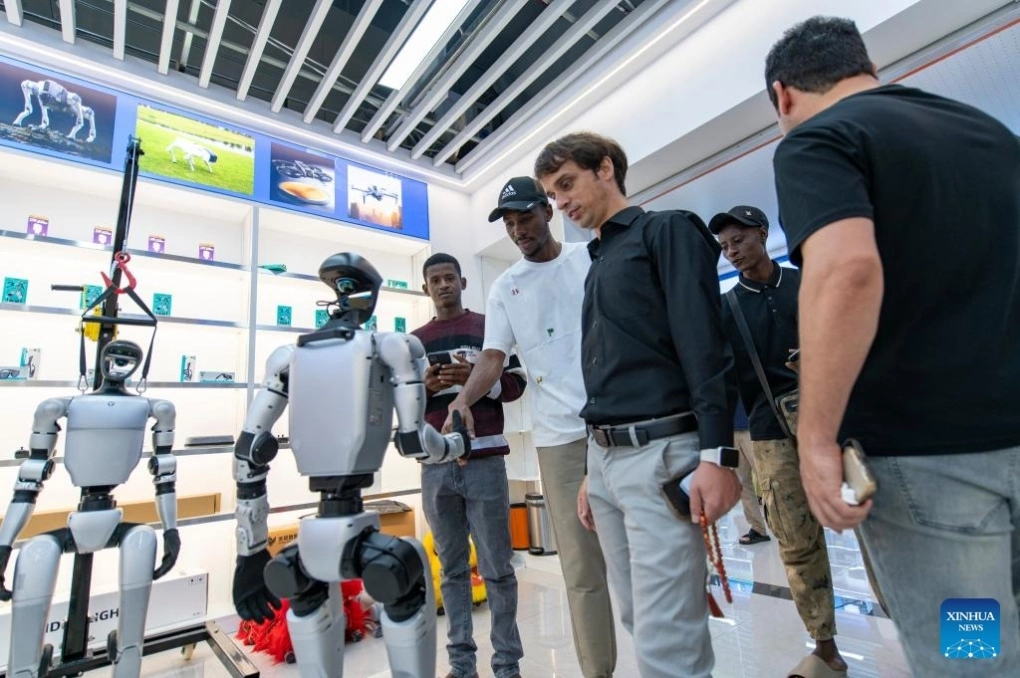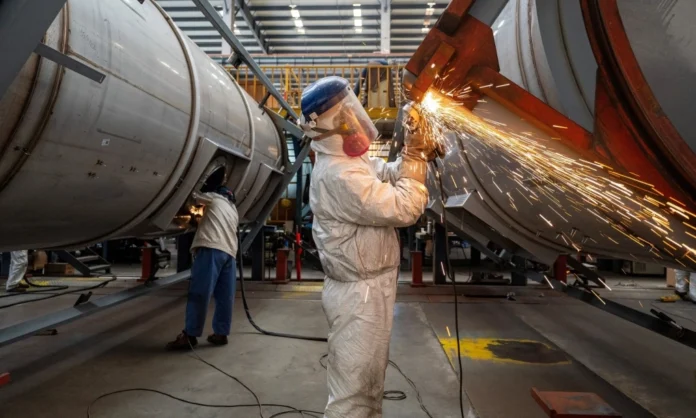[Reading level: C1 – Advanced]
In recent years, trade relations between the United States and China have remained tense, especially as Washington continues to restrict Beijing’s influence in strategic areas such as technology, clean energy, and global supply chains. Yet, China has maintained remarkable confidence thanks to a massive manufacturing base built over more than four decades of reform and opening up. This “fortress” — consisting of large-scale factories, dense networks of suppliers, and an abundant labor force — has allowed China to preserve its role as the “world’s factory” despite new trade barriers imposed by the U.S.
Under President Xi Jinping, China has focused not only on maintaining output but also on upgrading its industrial capacity. Many traditional industries have been modernized through automation and digital transformation, while high-tech sectors such as electric vehicles, renewable energy, industrial robots, and semiconductors have received substantial state investment. This strategy enables China to compete not only in low-cost production but also in higher-value segments of the global value chain.
One of the clearest symbols of China’s manufacturing power is Yiwu City in Zhejiang Province — often called “the world’s small commodities market.” More than 70,000 stalls there offer over two million kinds of products, from toys, clothing, and household goods to electronic components and drones. Yiwu’s production network operates like a sophisticated system, where small and medium-sized enterprises cooperate closely, sharing suppliers, technology, and labor. This interlinked structure creates remarkable flexibility: when the U.S. imposed high tariffs and cut imports, manufacturers immediately shifted toward Europe, Southeast Asia, Africa, and South America.
In practice, although exports to the U.S. have fallen by nearly 30% over the past year, China’s total exports have grown significantly, reaching over 328 billion USD in September — the highest level since the start of the year. Many small businesses in Zhejiang, Guangdong, and Fujian report stable demand from developing regions, particularly those participating in the Belt and Road Initiative. This vast network of trading partners has helped Chinese goods reduce their dependence on the American market.

At the same time, the Chinese government has rolled out numerous measures to support manufacturing and exports: tax cuts for small businesses, expanded credit access, improved domestic logistics, and heavy investment in industrial infrastructure. Local governments are racing to build “smart industrial clusters” directly connected to ports and airports, speeding up the movement of goods abroad. The rise of cross-border e-commerce platforms such as Alibaba, Temu, and Shein has further strengthened China’s global position, enabling millions of products to reach foreign consumers within days.
Nevertheless, this success seems to mask serious internal challenges. China’s economy faces sluggish consumption, weakening public confidence, a prolonged property crisis, and the risk of deflation. Heavy reliance on exports makes growth vulnerable to global fluctuations or protectionist policies from Western economies. Some economists warn that unless China boosts domestic consumption and innovation, the “export-driven” growth model could reach its limits in the coming years.
Moreover, the rivalry between the U.S. and China is not only about trade but also about long-term strategy. Washington seeks to limit China’s dominance in global supply chains, especially in critical sectors like rare materials, clean energy, and high technology. Yet, in reality, complete decoupling from China is nearly impossible. Companies in the U.S., Europe, and even Southeast Asia remain heavily dependent on Chinese components, materials, and intermediate goods. This dependence ensures China’s central role in global manufacturing — at least for the foreseeable future.
Meanwhile, the Xi administration appears to be using external pressure to reinforce domestic strength. By expanding investment in clean energy, electric vehicles, AI, biotechnology, and semiconductors, China aims to reduce dependence on the West while building new high-tech industries. Beijing is also actively promoting trade agreements with key partners in Asia, the Middle East, and Africa, seeking to broaden its economic sphere beyond U.S. influence.

Clearly, the demand for Chinese goods remains very strong at present. On a recent weekend, Yiwu International Trade City — one of six vast complexes designated by the local government for export goods — was bustling with lively scenes of buying, selling, and bargaining.
A toy drone buzzed near the onlookers, while a robot dog sat upright, waiting to be given a bone. Two men were testing toy AK-47 rifles loaded with rubber bullets.
Amid the bustling scene, 26-year-old entrepreneur Rhoda Nghelembi from Tanzania stopped at a stall to look at metal bracelets and earrings. Over the past three years, she has traveled to Yiwu seven times, bringing goods back to sell not only in her own country but also in Kenya, Uganda, and Congo.
“I believe I will become rich doing business with China,” Nghelembi said. “There are so many opportunities here.”
Source: https://vnexpress.net/thanh-luy-san-xuat-giup-trung-quoc-tu-tin-dau-thuong-mai-voi-my-4954207.html
WORD BANK:
restrict sb/sth /rɪˈstrɪkt/ [B2] (v): hạn chế ai/cái gì
manufacturing base /ˌmæn.jəˈfæk.tʃɚ.ɪŋ beɪs/ (n): nền tảng sản xuất, cơ sở công nghiệp
fortress /ˈfɔːr.trəs/ (n): pháo đài
dense /dens/ [C1] (adj): dày đặc
abundant /əˈbʌn.dənt/ [B2] (adj): phong phú, dồi dào
trade barrier /ˈtreɪd ˌbær.i.ɚ/ (n): rào cản thương mại
impose sth on sb/sth /ɪmˈpoʊz/ [C1] (v): áp đặt điều gì lên ai/cái gì
digital transformation /ˈdɪdʒ.ɪ.t̬əl ˌtræns.fɚˈmeɪ.ʃən/ (n): chuyển đổi số
semiconductor /ˌsem.i.kənˈdʌk.tɚ/ (n): chất bán dẫn
segment /ˈseɡ.mənt/ [C1] (n): phân khúc
stall /stɑːl/ (v): đình trệ, ngưng trệ
sophisticated /səˈfɪs.tə.keɪ.t̬ɪd/ [B2] (adj): tinh vi, phức tạp
enterprise /ˈen.t̬ɚ.praɪz/ [B2] (n): doanh nghiệp
flexibility /ˌflek.səˈbɪl.ə.t̬i/ [B2] (n): sự linh hoạt
tariff /ˈter.ɪf/ (n): thuế quan
shift toward sth /ʃɪft təˈwɔːrd/ (v): chuyển hướng sang điều gì
in practice /ɪn ˈpræk.tɪs/ (adv): trên thực tế
the Belt and Road Initiative /ðə belt ənd roʊd ɪˈnɪʃ.ə.t̬ɪv/ (n): Sáng kiến Vành đai và Con đường
roll out sth /roʊl aʊt/ (v): triển khai, tung ra
credit /ˈkred.ɪt/ (n): tín dụng
cluster /ˈklʌs.tɚ/ (n): cụm, nhóm (công nghiệp, công ty…)
cross-border /ˌkrɔːsˈbɔːr.dɚ/ (adj): xuyên biên giới
mask sth /mæsk/ (v): che giấu điều gì
sluggish /ˈslʌɡ.ɪʃ/ (adj): chậm chạp, trì trệ
prolonged /prəˈlɑːŋd/ [C1] (adj): kéo dài
deflation /diːˈfleɪ.ʃən/ (n): giảm phát
vulnerable to sth /ˈvʌl.nɚ.ə.bəl/ [C1] (adj): dễ bị tổn thương trước điều gì
protectionist policy /prəˈtek.ʃən.ɪst ˈpɑː.lə.si/ (n): chính sách bảo hộ thương mại
export-driven /ˈek.spɔːrt ˌdrɪv.ən/ (adj): dựa vào xuất khẩu
rivalry /ˈraɪ.vəl.ri/ (n): sự cạnh tranh
dominance /ˈdɑː.mə.nəns/ [C1] (n): vị thế thống trị
decouple sth from sth /ˌdiːˈkʌp.əl/ (v): tách rời cái gì khỏi cái gì
intermediate goods /ˌɪn.t̬ɚˈmiː.di.ət ɡʊdz/ (n): hàng hóa trung gian
foreseeable future /fɔːrˈsiː.ə.bəl ˈfjuː.tʃɚ/ (n): tương lai gần, có thể dự đoán được
external /ɪkˈstɝː.nəl/ [B2] (adj): bên ngoài
biotechnology /ˌbaɪ.oʊ.tekˈnɑː.lə.dʒi/ (n): công nghệ sinh học
designate /ˈdez.ɪɡ.neɪt/ [C1] (v): chỉ định, định danh
bustling /ˈbʌs.lɪŋ/ (adj): nhộn nhịp, tấp nập
bargain /ˈbɑːr.ɡɪn/ [B2] (n): món hời, sự mặc cả
buzz /bʌz/ (v): vo ve, rì rầm (âm thanh náo nhiệt)
onlooker /ˈɑːnˌlʊk.ɚ/ (n): người xem, người đứng nhìn
rifle /ˈraɪ.fəl/ (n): súng trường
rubber bullet /ˌrʌb.ɚ ˈbʊl.ɪt/ (n): đạn cao su
bracelet /ˈbreɪ.slət/ [A2] (n): vòng tay
earrings /ˈɪr.ɪŋz/ [A2] (n): hoa tai, khuyên tai
ỦNG HỘ READ TO LEAD!
Chào bạn! Có thể bạn chưa biết, Read to Lead là một trang giáo dục phi lợi nhuận với mục đích góp phần phát triển cộng đồng người học tiếng Anh tại Việt Nam. Chúng tôi không yêu cầu người đọc phải trả bất kỳ chi phí nào để sử dụng các sản phẩm của mình để mọi người đều có cơ hội học tập tốt hơn. Tuy nhiên, nếu bạn có thể, chúng tôi mong nhận được sự hỗ trợ tài chính từ bạn để duy trì hoạt động của trang và phát triển các sản phẩm mới.
Bạn có thể ủng hộ chúng tôi qua 1 trong 2 cách dưới đây.
– Cách 1: Chuyển tiền qua tài khoản Momo.
Số điện thoại 0947.886.865 (Chủ tài khoản: Nguyễn Tiến Trung)
Nội dung chuyển tiền: Ủng hộ Read to Lead
hoặc
– Cách 2: Chuyển tiền qua tài khoản ngân hàng.
Ngân hàng VIB chi nhánh Hải Phòng
Số tài khoản: 012704060048394 (Chủ tài khoản: Nguyễn Tiến Trung)
Nội dung chuyển tiền: Ủng hộ Read to Lead
Lớp luyện thi IELTS online
Bạn đang có nhu cầu thi chứng chỉ IELTS cho đầu vào đại học, đi du học, xin việc hay xin cư trú và đang phân vân chưa biết học ở đâu?
Nếu bạn đang tìm kiếm dịch vụ luyện thi IELTS online với giáo viên uy tín và chất lượng, cũng như học phí phải chăng, thì thầy Trung và Cô Thủy (Admin và dịch giả chính của Read to Lead) có thể là một lựa chọn phù hợp dành cho bạn.
Hãy liên hệ (nhắn tin) tới trang Facebook cá nhân của mình (https://www.facebook.com/nguyen.trung.509) để tìm hiểu về lớp học và được tư vấn cũng như được học thử nha!





